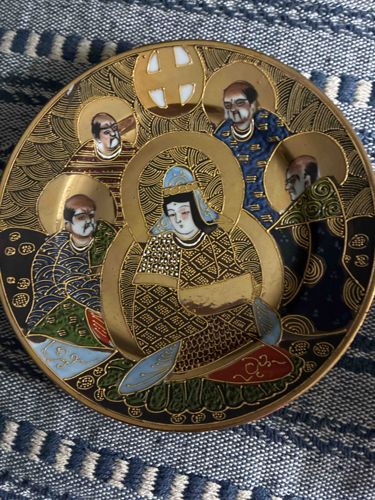
Japanese Cloisonné Plate with Buddhist Figures
This is a round cloisonné plate, likely of Japanese origin, adorned with intricate depictions of Buddhist figures. The central figure appears to be a bodhisattva or enlightened being, seated in a meditative pose. Around this central figure are four additional smaller figures, possibly arhats or monks, each enclosed within a circular halo. A fifth, smaller halo-enclosed motif, possibly a stylized symbol or another figure, is subtly visible at the top. The plate exhibits a rich color palette, primarily featuring a deep gold background for the figures and their halos, contrasted with vibrant blues, greens, reds, and black for their robes and the surrounding decorative patterns. The gold areas display fine-line detailing, including wave-like or concentric patterns, and geometric motifs on the garments of the central figure. The robes of the subsidiary figures also feature various intricate patterns. The cloisonné technique is evident in the raised gold wire outlines separating the different enamel color fields. There are some visible signs of wear, particularly on the central figure's lower garment and lap, where the enamel appears slightly abraded or scratched, revealing a darker layer beneath. The gold wirework seems well-preserved overall, contributing to the item's perceived quality. The edge of the plate is defined by a subtle, unassuming rim, likely also gilt metal. Based on the style of the figures, the intricate enameling, and the use of gold within the design, this piece likely dates from the Meiji period (1868-1912) or early 20th century, a peak era for Japanese cloisonné production. The craftsmanship suggests a high level of artistic skill and painstaking detail, indicating it was manufactured for decorative or ceremonial purposes.
AI-Generated Appraisal Disclaimer
Estimated Value
$1,800-2,500
Basic Information
Category
Decorative Arts
Appraised On
December 7, 2025
Estimated Value
$1,800-2,500
Item Description
This is a round cloisonné plate, likely of Japanese origin, adorned with intricate depictions of Buddhist figures. The central figure appears to be a bodhisattva or enlightened being, seated in a meditative pose. Around this central figure are four additional smaller figures, possibly arhats or monks, each enclosed within a circular halo. A fifth, smaller halo-enclosed motif, possibly a stylized symbol or another figure, is subtly visible at the top. The plate exhibits a rich color palette, primarily featuring a deep gold background for the figures and their halos, contrasted with vibrant blues, greens, reds, and black for their robes and the surrounding decorative patterns. The gold areas display fine-line detailing, including wave-like or concentric patterns, and geometric motifs on the garments of the central figure. The robes of the subsidiary figures also feature various intricate patterns. The cloisonné technique is evident in the raised gold wire outlines separating the different enamel color fields. There are some visible signs of wear, particularly on the central figure's lower garment and lap, where the enamel appears slightly abraded or scratched, revealing a darker layer beneath. The gold wirework seems well-preserved overall, contributing to the item's perceived quality. The edge of the plate is defined by a subtle, unassuming rim, likely also gilt metal. Based on the style of the figures, the intricate enameling, and the use of gold within the design, this piece likely dates from the Meiji period (1868-1912) or early 20th century, a peak era for Japanese cloisonné production. The craftsmanship suggests a high level of artistic skill and painstaking detail, indicating it was manufactured for decorative or ceremonial purposes.
Get Your Items Appraised
Instant estimates of your treasures with AI-powered instant appraisals